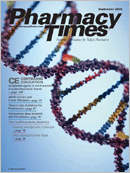Publication
Article
Pharmacy Times
case STUDY
Author(s):
CASE:QT, a 1-year-old boy, wasbrought to the pharmacy byhis mother. His mother complainedthat QT refused to eat,taking in only minimal fluids.The mother explained thatQT had a fever that wouldnot resolve. For the last 6days, he had a temperatureof 104°F. After the first day ofthe fever, QT developed a diffuse, "blotchy" rash. Initially, therash was limited to the diaper area, but it had spread to histrunk and extremities. The mother reported that QT's perinealarea was also red and raw-appearing. She said theouter layer of skin around the perineum appears to be scalingoff. Today, the mother noticed that the inside of QT'smouth looked irritated and red. She also feels a "lump" onhis neck that she thinks is a "really big lymph node just likemy brother had when he was sick as a child."
Upon further questioning, the pharmacist learns that QT'smother's pregnancy with him was unremarkable, resulting in afull-term spontaneous delivery without complications. QT is upto-date on his immunizations. He does not have any knownallergies. Currently, the only medications he is receiving areacetaminophen and ibuprofen for his fever. QT has not recentlyhad a runny nose, cough, vomiting, or diarrhea. He is an onlychild who has not been exposed to other sick children.
While asking QT's mother for more information, the pharmacistnotices that QT is extremely irritable and ill-appearing. Shenotes that the rash is maculopapular. His eyelids appearswollen. She also notices subtle edema of the dorsal, palmar,and plantar surfaces of QT's hands and feet. When QT cries, thepharmacist notices an inflamed oral mucosa, a "strawberrytongue,"and cracked lips.
The pharmacist and the mother are unaware that anotherwoman is standing only a few feet away, listening to their entireconversation. As the woman steps out from behind the wallthat had obscured her from view, she points at QT andattempts to apologize for interrupting. She explains that herEnglish is not fluent but that she understood what they werediscussing. Although the pharmacist and mother are unable tocomprehend most of what she says, the pharmacist hears theword "Kawasaki."
Suddenly the pharmacist remembers that Kawasaki diseaseis characterized by:
- Fever lasting at least 5 days
- Changes in the mouth, including diffuse erythema and fissures
- Conjunctival swelling
- Enlarged cervical lymph nodes
- Erythematous rash, often with perineal scaling
- Edema of the hands and feet, followed by skin peeling
The pharmacist explains to QT's mother that she thinks theother woman was attempting to say that she believed QT hasKawasaki disease. She also explains that QT's symptoms areconsistent with the syndrome.
Relieved that she has a tentative diagnosis, the mother saysshe feels "better just having an idea what is wrong with mybaby. It is difficult to see your own child sick." She thanks thepharmacist for her time and turns to leave.
Should the pharmacist allow the mother to simply walkaway or should she advise her to seek medical care for QT?
Dr. Schlesselman is an assistant clinical professor at the University of Connecticut School of Pharmacy.
Click Here For The Answer ----------->
[-]
CASE: The pharmacist should advise QT's mother to seek medical attention for him. The pharmacist can provide the mother withnumerous reasons that medical care is needed:
1. Although the diagnosis of Kawasaki disease is based on clinical presentation, a physician can more accurately diagnose the cause of QT's illness thanthe pharmacist.
2. With such a young child, prolonged fever can lead to severe dehydration.
3. If QT does have Kawasaki disease, the physician will treat QT with a single infusion of intravenous immune globulin and oral high-dose aspirin. Earlytreatment can reduce the risk of developing the most serious adverse effect associated with Kawasaki, coronary artery aneurysm.Without treatment,20% of children will develop a coronary artery aneurysm.
toggle(getObject('exp1048685570_link'), 'exp1048685570');







